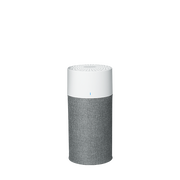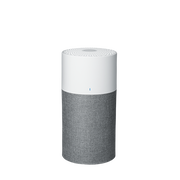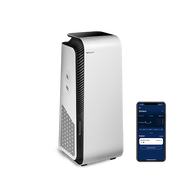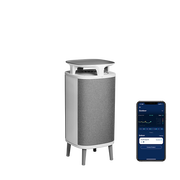
The relationship
between air purifiers
and microplastics
What you need to know
Indoor air pollution is a growing concern as people spend more time indoors than ever before. Poor indoor air quality can lead to a range of health issues, including respiratory problems, headaches, and allergies.
One of the lesser-known indoor air pollutants is microplastics. These small plastic particles can come from a variety of sources, including household items like clothing, furniture, and packaging. In this article, we will explore the relationship between air purifiers and microplastics and how air purifiers can help improve indoor air quality.
What are microplastics?
Microplastics are small plastic particles that are less than 5mm in size. They can come from a variety of sources, including household items like clothing, furniture, and packaging. These particles are so small that they can easily become airborne and enter your home's indoor air. Once in the air, they can be inhaled and potentially cause health problems.
Are there any health risks of microplastics?
Research has shown that exposure to microplastics can have a range of negative health effects. These include respiratory problems, cardiovascular issues, and even cancer. In addition, microplastics can also have negative effects on the environment, as they can accumulate in waterways and harm marine life.
How air purifiers can help
Air purifiers are designed to remove pollutants from the air, including microplastics. Blueair's HEPASilent™ technology is designed to capture at least 99.97% of airborne particles as small as 0.1² microns in size. By combining electrostatic and mechanical filtration technologies, our filters delivers especially high performance and efficiency.
This means that all our air purifiers are capable of capturing microplastics, which are typically larger than this size. By using an air purifier in your home, you can help reduce your exposure to microplastics and improve your indoor air quality.
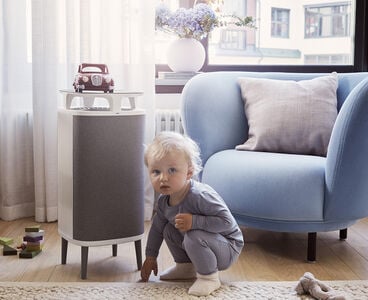
Choosing the right air purifier
When choosing an air purifier, it's important to look for one that is capable of capturing microplastics. Air purifiers with HEPA filter or with HEPASilent™ technology are the most effective at capturing small particles. In addition, consider the size of the room you will be using the purifier in, as well as any additional features you may want, such as an air quality monitor etc.

Other ways to reduce microplastics in your home
While air purifiers are an effective way to reduce your exposure to microplastics, there are other steps you can take to minimize your exposure. These include:
- Choosing products with less plastic packaging
- Using natural fabrics like cotton and wool instead of synthetic materials like polyester
- Washing synthetic clothing on a gentle cycle to reduce shedding
- Avoiding products with microbeads, which are tiny plastic particles used in some beauty products
FAQs
Can air purifiers completely eliminate microplastics from indoor air?
While air purifiers can help reduce your exposure to microplastics, they cannot completely eliminate them from indoor air. However, microplastics is mostly a water problem, and not so much in air. Indoors, there could be some from textiles etc but as they are big and heavy they will rapidly fall to the floor. Under normal indoor conditions the air is relatively free from microplastics, and also not found in outdoor air.
Read more about Particulate Matter (PM) in the air.
Can microplastics be harmful to pets?
Yes, just like humans, pets can also be harmed by exposure to microplastics.
Are there any other benefits to using an air purifier besides reducing microplastics?
Yes, air purifiers can also help remove other pollutants from indoor air, such as dust, pollen, and pet dander.
Conclusion
As you may already be aware of, microplastics are a growing concern in indoor air quality. These small plastic particles can have negative effects on both our health and the environment. Fortunately, air purifiers are an effective way to reduce your exposure to microplastics and improve your indoor air quality. When choosing an air purifier, be sure to look for one with a HEPA filter or HEPASilent™ technology and consider additional features that may be important to you.
In addition to using an air purifier, there are also steps you can take to minimize your exposure to microplastics, such as choosing products with less plastic packaging and washing synthetic clothing on a gentle cycle. By taking these steps, you can help protect your health and the environment from the negative effects of microplastics.
Blueair air purifiers are simple to use and have something special: We are the only major air purifier brand to verify 100% of our models for performance for Clean Air Delivery Rate (CADR).
Sources, Fate and Effects of Microplastics in the Marine Environment: Part Two of a Global Assessment. "United Nations Environment Programme, 2017, https://wedocs.unep.org/bitstream/handle/20.500.11822/25496/GPA%20Summary%20of%20findings%20and%20recommendations.pdf?sequence=1&isAllowed=y.
Plastics in Your Home." Plastic Pollution Coalition, https://www.plasticpollutioncoalition.org/plastics-in-your-home.
Air Purifiers: A Guide to the Best Clean Air Machines." Wirecutter, 17 Feb. 2022, https://www.nytimes.com/wirecutter/reviews/best-air-purifier/.

